At ValidExamDumps, we consistently monitor updates to the Arcitura Education S90.08B exam questions by Arcitura Education. Whenever our team identifies changes in the exam questions,exam objectives, exam focus areas or in exam requirements, We immediately update our exam questions for both PDF and online practice exams. This commitment ensures our customers always have access to the most current and accurate questions. By preparing with these actual questions, our customers can successfully pass the Arcitura Education SOA Design & Architecture Lab with Services & Microservices exam on their first attempt without needing additional materials or study guides.
Other certification materials providers often include outdated or removed questions by Arcitura Education in their Arcitura Education S90.08B exam. These outdated questions lead to customers failing their Arcitura Education SOA Design & Architecture Lab with Services & Microservices exam. In contrast, we ensure our questions bank includes only precise and up-to-date questions, guaranteeing their presence in your actual exam. Our main priority is your success in the Arcitura Education S90.08B exam, not profiting from selling obsolete exam questions in PDF or Online Practice Test.
Refer to Exhibit.
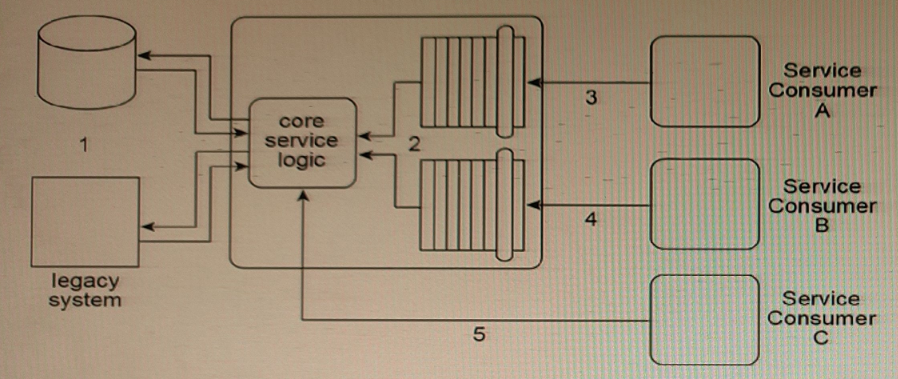
The architecture for Service A displayed in the figure shows how the core logic of Service A has expanded over time to connect to a database and a proprietary legacy system (1), and to support two separate service contracts (2) that are accessed by different service consumers.
The service contracts are fully decoupled from the service logic. The service logic is therefore coupled to the service contracts and to the underlying implementation resources (the database and the legacy system).
Service A currently has three service consumers. Service Consumer A and Service Consumer B access Service A's two service contracts (3, 4). Service Consumer C bypasses the service contracts and accesses the service logic directly (5).
You are told that the database and legacy system that are currently being used by Service A are being replaced with different products. The two service contracts are completely decoupled from the core service logic, but there is still a concern that the introduction of the new products will cause the core service logic to behave differently than before.
What steps can be taken to change the Service A architecture in preparation for the introduction of the new products so that the impact on Service Consumers A and B is minimized? What further step can be taken to avoid consumer-to-implementation coupling with Service Consumer C?
The Service Fagade pattern can be applied to position fagade components between the core service logic and the implementation resources (the database and the legacy system). These fagade components will be designed to insulate the core service logic of Service A from the changes in the underlying implementation resources. This will minimize the impact of the introduction of the new products on Service Consumers A and B since the service contracts are fully decoupled from the core service logic. The Schema Centralization and Endpoint Redirection patterns can also be applied to force Service Consumer C to access Service A via one of its existing service contracts, avoiding direct access to the core service logic and the underlying implementation resources.
Refer to Exhibit.
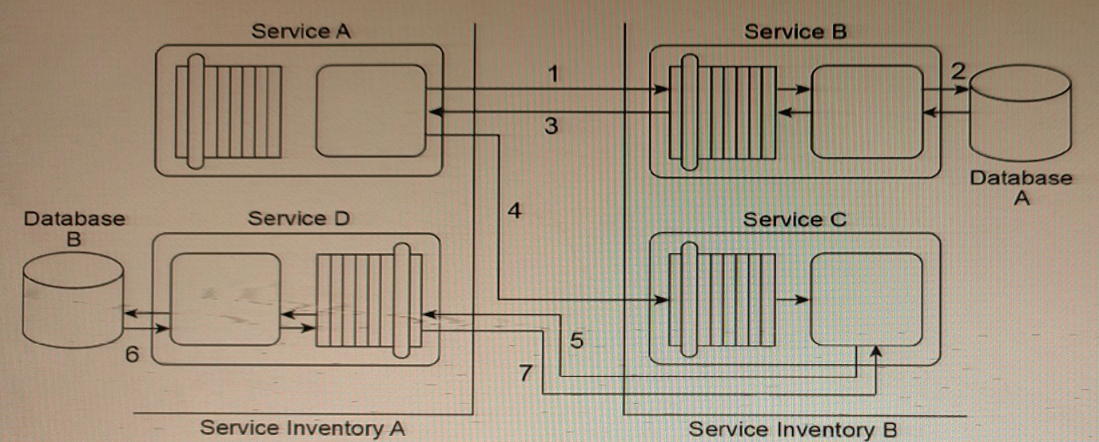
Service A sends a message to Service B (1). After Service B writes the message contents to Database A (2), it issues a response message back to Service A (3). Service A then sends a message to Service C (4). Upon receiving this message, Service C sends a message to Service D (5), which then writes the message contents to Database B (6) and issues a response message back to Service C (7).
Service A and Service D are located in Service Inventory
This solution addresses the two main challenges in the service composition architecture: the different XML schema used by services in Service Inventory A and Service Inventory B, and the incompatible data formats of the two databases.
By applying the Data Model Transformation pattern, data model transformation logic can be inserted to map the invoice-related data between the different XML schemas used by the services in Service Inventory A and Service Inventory B. This can be done at the appropriate points in the message flow: between Service A and Service B, between Service A and Service C, between Service C and Service D, and between the Service D logic and Database B.
By applying the Data Format Transformation pattern, data format transformation logic can be inserted to convert the XML-formatted data used by the services to the CSV format required by Database A, and to convert the proprietary XML schema used by Database B to the XML schema used by the services. This can be done between the Service B logic and Database A.
The Protocol Bridging pattern is not necessary in this case because all services are already communicating using the same protocol (presumably HTTP or a similar protocol).
Refer to Exhibit.
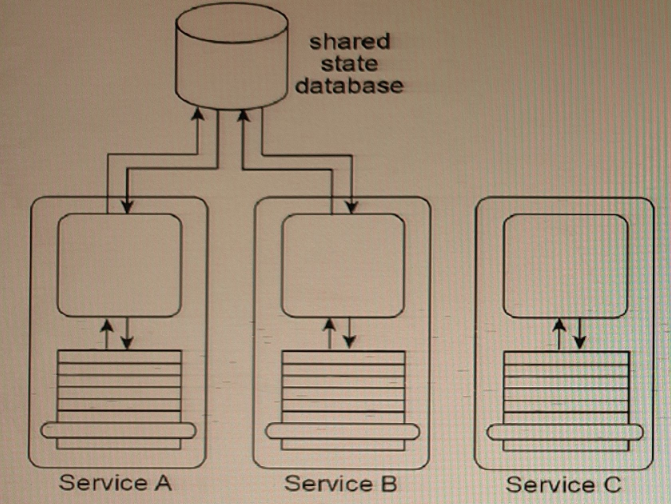
Services A, B, and C are non-agnostic task services. Service A and Service B use the same shared state database to defer their state data at runtime.
An assessment of the three services reveals that each contains some agnostic logic that cannot be made available for reuse because it is bundled together with non-agnostic logic.
The assessment also determines that because Service A, Service B and the shared state database are each located in physically separate environments, the remote communication required for Service A and Service B to interact with the shared state database is causing an unreasonable decrease in runtime performance.
How can the application of the Orchestration pattern improve this architecture?
The application of the Orchestration pattern can improve this architecture by cleanly separating the non-agnostic logic from the agnostic logic, allowing the design of new agnostic services with reuse potential. The State Repository pattern, which is supported by and local to the orchestration environment, provides a central state database that can be shared by Services A and B. The local state database avoids problems with remote communication. Additionally, the Orchestration pattern provides a central controller that can coordinate the interactions between Services A, B, and C, reducing the need for remote communication between services and improving runtime performance.
Refer to Exhibit.
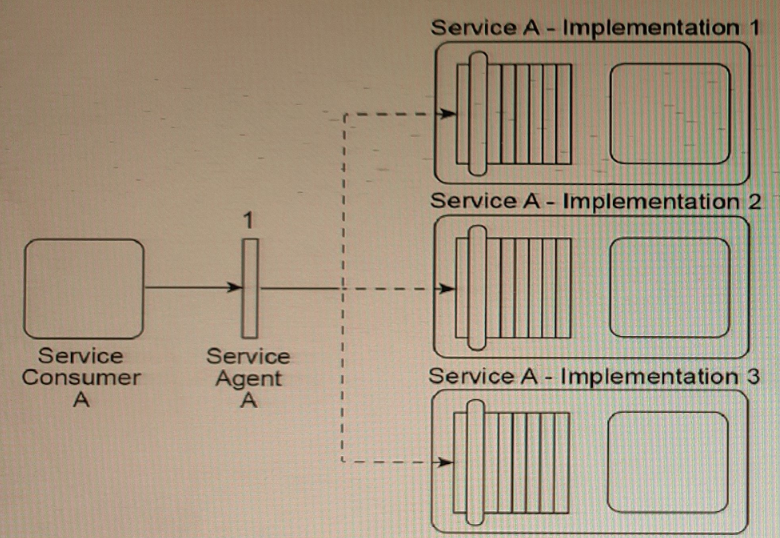
Service Consumer A sends a message to Service
By separating the individual implementations of Service A onto different physical servers, they can be isolated from each other and from other clients and applications in the IT enterprise, which can help improve performance. Additionally, using the Service Data Replication pattern to give each implementation of Service A its own copy of the data it requires from the shared database can help reduce the load on the shared database and improve performance. This can be especially important when a new service capability is added that requires access to the shared database, as it can help ensure that the performance of Service A is not impacted by the additional demands placed on the shared database.
Refer to Exhibit.
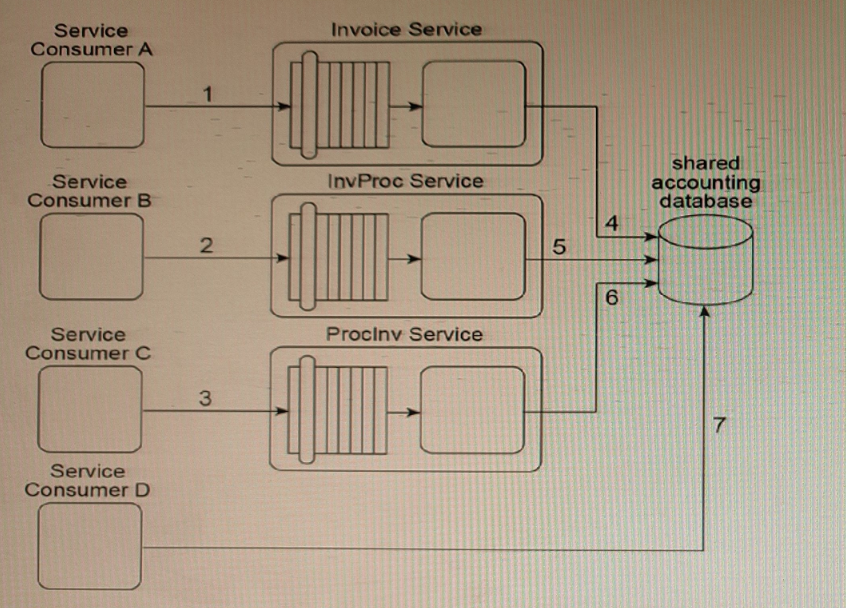
Our service inventory contains the following three services that provide Invoice-related data access capabilities: Invoice, InvProc and Proclnv. These services were created at different times by different project teams and were not required to comply with any design standards. Therefore, each of these services has a different data model for representing invoice data.
Currently, each of these three services has a different service consumer: Service Consumer A accesses the Invoice service (1), Service Consumer B (2) accesses the InvProc service, and Service Consumer C (3) accesses the Proclnv service. Each service consumer invokes a data access capability of an invoice-related service, requiring that service to interact with the shared accounting database that is used by all invoice-related services (4, 5, 6).
Additionally, Service Consumer D was designed to access invoice data from the shared accounting database directly (7). (Within the context of this architecture, Service Consumer D is labeled as a service consumer because it is accessing a resource that is related to the illustrated service architectures.)
Assuming that the Invoice service, InvProc service and Proclnv service are part of the same service inventory, what steps would be required to fully apply the Official Endpoint pattern?
he Legacy Wrapper pattern can be applied so that Component B is separated into a separate utility service that wraps the shared database. The Legacy Wrapper pattern can be applied again so that Component C is separated into a separate utility service that acts as a wrapper for the legacy system API. The Legacy Wrapper pattern can be applied once more to Component D so that it is separated into another utility service that provides standardized access to the file folder. The Service Facade pattern can be applied so that three facade components are added: one between Component A and each of the new wrapper utility services. This way, the facade components can compensate for any change in behavior that may occur as a result of the separation. The Service Composability principle can be further applied to Service A and the three new wrapper utility services so that all four services are optimized for participation in the new service composition. This will help make up for any performance loss that may result from splitting the three components into separate services.
By applying the Legacy Wrapper pattern to separate Components B, C, and D into three different utility services, the shared resources within the IT enterprise (Database A, the legacy system, and the file folders) can be properly encapsulated and managed by dedicated services. The Service Facade pattern can then be used to create a facade component between Component A and each of the new wrapper utility services, allowing them to interact seamlessly without affecting Service Consumer A's behavior.
Finally, the Service Composability principle can be applied to ensure that Service A and the three new wrapper utility services are optimized for participation in the new service composition. This will help to mitigate any performance loss that may result from splitting the three components into separate services.